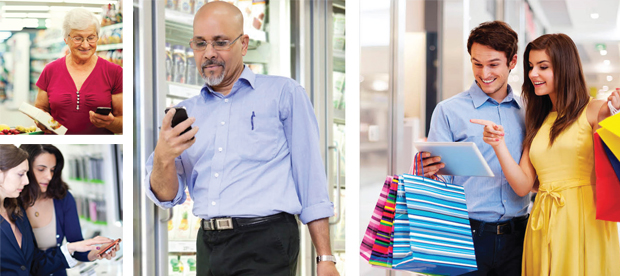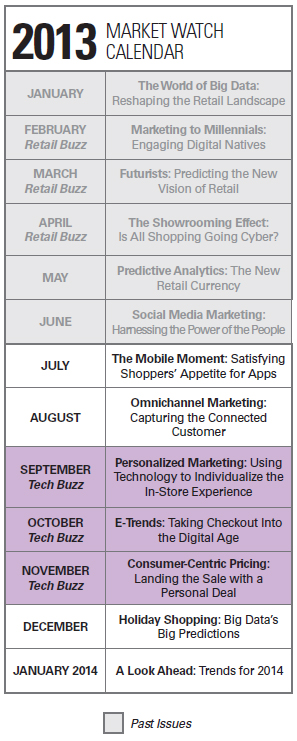
Smartphones and apps are the baby boom of the 21st century. Today, there are more than 1 billion smartphones in use around the world and 56 billion app downloads each year. This boom extends to the retail environment, where shoppers are using smartphones every day to research and compare virtually every type of product in every type of store. By creating their own branded mobile solutions, rather than leaving shoppers to the devices of unaffiliated and potentially unfavorable third-party apps, retailers and CPGs can take control of the consumer experience, satisfying shoppers’ cravings for on-the-go connection while simultaneously driving in-store traffic, growth and loyalty.
However, this is not a simple case of “if you build it, they will come.” Shoppers might download a retailer or CPG app at first just because “it’s there,” but if they don’t see clear benefits, they won’t use it. “The customer is going to bring a set of interests and values [with him or her],” says Greg Girard, Program Director, Merchandising and Marketing Strategies and Retail Analytics for IDC Retail Insights. “[To be successful] apps have to keep those customer interests in mind.”
Fortunately, consumers are clear on what they want from retail apps. According to a survey by Compuware, a technology performance company, shoppers are looking for mobile solutions that make their lives easier and save them money—for example, providing instant access to product and store information, assisting in planning and navigating store trips, and delivering personalized content, including offers and rewards based on shoppers’ unique interests. While these end-goals are fairly uniform, the way in which individual retailers and CPGs deliver those experiences can help separate them from the rest of pack. Here’s an inside look at some of the top technologies capturing shoppers’ attention—and delivering ROI for retailers and CPGs—today.
Crowdsourcing
Imagine you’re waiting at the doctor’s office. You pull out your phone, use an app to pick out the ingredients you need to make dinner, and when you get home a couple of hours later, a personal shopper meets you at your door with the groceries you just ordered. This type of scenario is exactly what the Instacart app is delivering to shoppers in the San Francisco, CA area, thanks to the power of crowdsourcing—soliciting contributions from a large group of people to provide a certain set of services. With Instacart, a shopper selects from a list of local stores, chooses which grocery items he or she wants and specifies a time-frame for delivery. The order is then sent out to one of Instacart’s crowdsourced web of personal shoppers, who complete the order for a previously specified fee.
–Colin Haig, SAP
This type of app is ripe for retailer-specific optimization, allowing shoppers to order their favorite grocery items and brands from their preferred stores with the click of a button—all the while driving brand growth and loyalty. And the use of crowdsourcing means little to no investment for retailers in hiring additional employees, providing delivery vehicles and other resources that would be necessary with a traditional grocery delivery service.
Mobile shopping incentives
Mobile incentives are the cornerstone of precision retailing today. “It’s all about making that one-to-one personalized offer that can impact the customers’ behavior at the point of decision,” says Colin Haig, Retail Program Principal for SAP, a business management software firm. For CPGs, such offers may be made, for example, through a recipe app that provides e-coupons for select brand ingredients. The coupon can be instantly added to customer-provided retail loyalty cards and redeemed before the shopper leaves the store. For retailers, incentives can be tied to an app that’s linked to a shopper’s loyalty card to offer personalized deals based on previous and predicted shopping behavior. Such promotions encourage shoppers to travel further into stores and increase shopper spending, according to a recent study published by the American Marketing Association.

Interactions is currently exploring the development of a mobile incentive app that would integrate with retailer- or CPG-sponsored in-store events. Shoppers who sample at an in-store event would be able to use the app to scan a QR (quick-read) code placed on a sign at the event cart to receive an instant coupon for the item being sampled. The coupon would also automatically be shared with friends on social media so they can get the deal, too. The discounts would be retailer-specific, not only increasing CPG sales of the products being sampled, but also driving traffic into stores.
In-store location features
In-store location technology builds on the popularity of outdoor mapping and GPS. “Location-based apps provide the context—like what’s on the customer’s shopping list, where they are in the store—that’s critical for… [driving] interaction and [offering] content that the customer values,” says Girard. For example, Midwest retailer Meijer recently developed a new app that provides detailed interior maps of select stores and features a product locator that allows users to instantly find the location of any one of the over 300,000 items the retailer offers in its supercenters. These in-store location features interface with a built-in customizable shopping list and mobile ad circular, allowing shoppers to map out the most efficient route to take to fulfill their list and/or instantly locate sale items. In a study by Point Inside, a mobile app software company, shoppers who had access to a version of an app with this type of in-store technology used it five times as often as shoppers who had a version without the technology. The study also found that this additional use led to more shopping trips at the retailer and an increased basket spend during each tip.
Well-designed and well-executed retail apps help extend the consumer experience both pre- and post-shopping, offering significant potential for brand growth and loyalty. They also help bridge the virtual and physical retail worlds—serving as a critical piece of the omnichannel puzzle many retailers and CPGs are striving to assemble. Developing an own-branded app, therefore, sets retailers and CPGs up to not only leverage the mobile boom—but the future of shopping as a whole.

